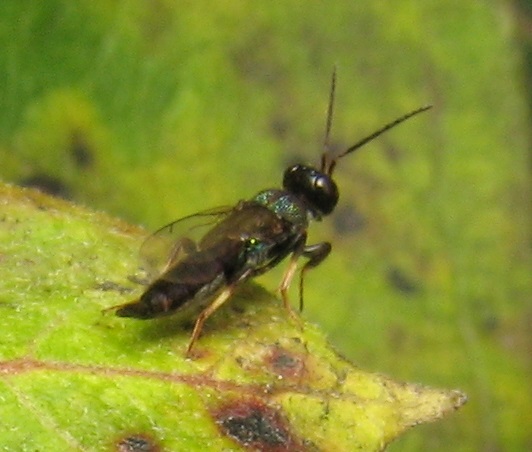Eupelmidae on:
[Wikipedia]
[Google]
[Amazon]
Eupelmidae is a family of
DOIPDF
/ref>
Universal Chalcidoidea Database
{{Authority control Apocrita families Taxa named by Francis Walker (entomologist)
parasitic wasp
Parasitoid wasps are a large group of hymenopteran superfamilies, with all but the wood wasps ( Orussoidea) being in the wasp-waisted Apocrita. As parasitoids, they lay their eggs on or in the bodies of other arthropods, sooner or later causi ...
s in the superfamily Chalcidoidea
Chalcid wasps (, , for their metallic colour) are insects within the superfamily Chalcidoidea, part of the order Hymenoptera. The superfamily contains some 22,500 known species, and an estimated total diversity of more than 500,000 species, m ...
. The larva
A larva (; : larvae ) is a distinct juvenile form many animals undergo before metamorphosis into their next life stage. Animals with indirect development such as insects, some arachnids, amphibians, or cnidarians typically have a larval phase ...
e of the majority are primary parasitoid
In evolutionary ecology, a parasitoid is an organism that lives in close association with its host (biology), host at the host's expense, eventually resulting in the death of the host. Parasitoidism is one of six major evolutionarily stable str ...
s, commonly on beetle
Beetles are insects that form the Taxonomic rank, order Coleoptera (), in the superorder Holometabola. Their front pair of wings are hardened into wing-cases, elytra, distinguishing them from most other insects. The Coleoptera, with about 40 ...
larvae, though many other hosts are attacked, including spider
Spiders (order (biology), order Araneae) are air-breathing arthropods that have eight limbs, chelicerae with fangs generally able to inject venom, and spinnerets that extrude spider silk, silk. They are the largest order of arachnids and ran ...
s. Details of the life history varies considerably (e.g., some attack eggs and others are hyperparasite
A hyperparasite, also known as a metaparasite, is a parasite whose host, often an insect, is also a parasite, often specifically a parasitoid. Hyperparasites are found mainly among the wasp-waisted Apocrita within the Hymenoptera, and in two ot ...
s). They are found throughout the world in virtually all habitats.
Description
They are somewhat variable in appearance, though a fair number of species are relatively easy to separate from otherChalcidoidea
Chalcid wasps (, , for their metallic colour) are insects within the superfamily Chalcidoidea, part of the order Hymenoptera. The superfamily contains some 22,500 known species, and an estimated total diversity of more than 500,000 species, m ...
by the possession of a medially concave mesonotum
The mesothorax is the middle of the three segments of the thorax of hexapods, and bears the second pair of legs. Its principal sclerites (exoskeletal plates) are the mesonotum (dorsal), the mesosternum ( ventral), and the mesopleuron (lateral) ...
. They also have the unusual tendency to arch the body strongly upwards when dead, with the head and metasoma
The metasoma is the posterior part of the body, or tagma (biology), tagma, of arthropods whose body is composed of three parts, the other two being the prosoma and the mesosoma. In insects, it contains most of the digestive tract, respiratory sy ...
often nearly touching above the thorax.Gibson, G. A. (1986). Mesothoracic skeletomusculature and mechanics of flight and jumping in Eupelminae (Hymenoptera, Chalcidoidea: Eupelmidae) 1. The Canadian Entomologist, 118(7), 691-728DOI
/ref>

Taxonomy
In 2022, genera previously placed in this family were moved to the families Metapelmatidae and Neanastatidae. As presently defined, there are 39 genera in Eupelmidae.Subfamily Calosotinae
Genera remaining after the loss of five genera to Eusandalinae: *'' Balcha'' *'' Calosota'' *'' Tanythorax''Subfamily Eusandalinae
Genera: *'' Archaeopelma'' *'' Eusandalum'' *'' Licrooides'' *'' Paraeusandalum'' *'' Pentacladia''Subfamily Eupelminae
Genera: *'' Anastatus'' *'' Arachnophaga'' *'' Australoodera'' *'' Brasema'' *'' Calymmochilus'' *'' Cervicosus'' *'' Coryptilus'' *'' Ecnomocephala'' *'' Enigmapelma'' *'' Eueupelmus'' *'' Eupelmus'' *'' Eutreptopelma'' *'' Lecaniobius'' *'' Lutnes'' *'' Macreupelmus'' *'' Merostenus'' *'' Mesocomys'' *'' Omeganastatus'' *'' Ooderella'' *'' Oozetetes'' *'' Paranastatus'' *'' Phenaceupelmus'' *'' Phlebopenes'' *'' Psomizopelma'' *'' Rhinoeupelmus'' *'' Taphronotus'' *'' Tineobiopsis'' *'' Tineobius'' *'' Uropelma'' *'' Xenanastatus'' *'' Zaischnopsis''References
External links
Universal Chalcidoidea Database
{{Authority control Apocrita families Taxa named by Francis Walker (entomologist)